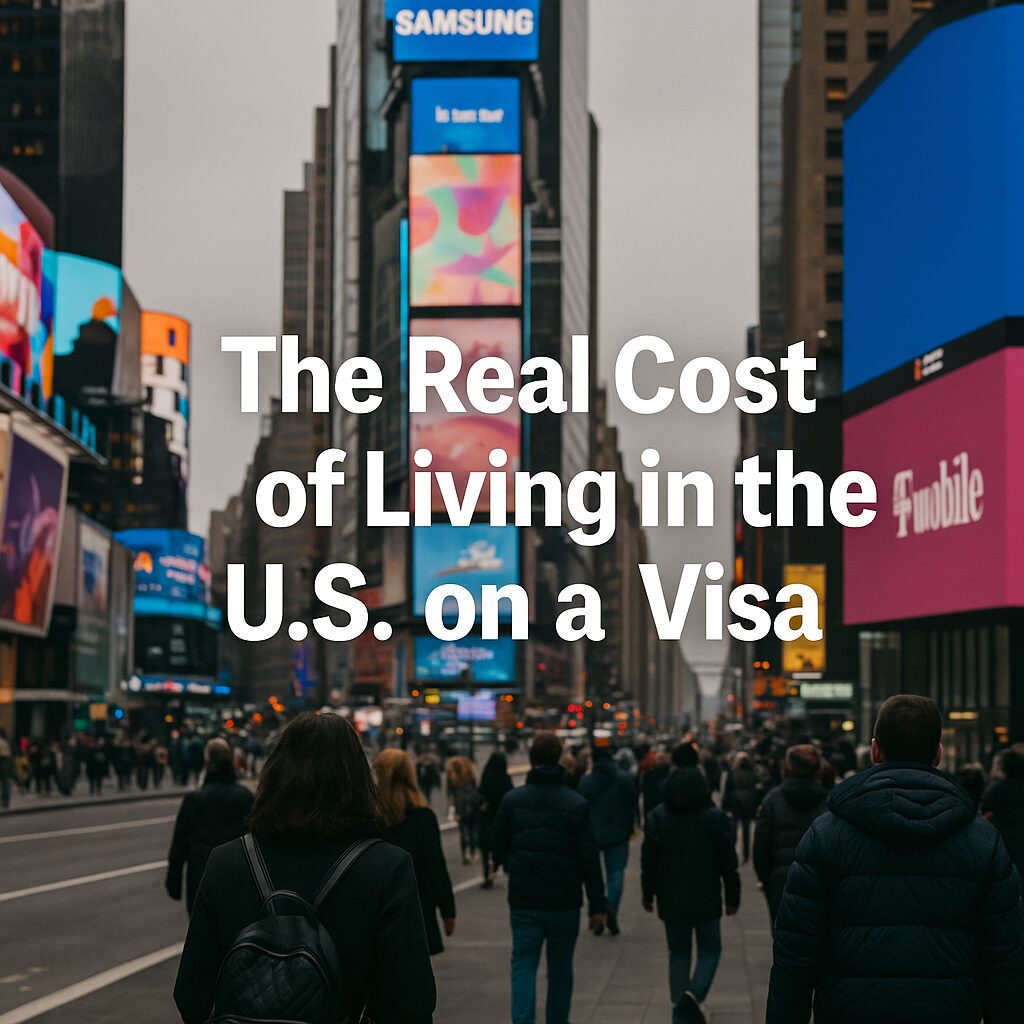Why This Guide Matters
Many people think that once they get a U.S. visa, their biggest challenge is over. But that’s only the beginning. Living in the United States can be expensive—even for locals. For immigrants, international workers, and students on visas, the challenge is even greater: limited work options, unfamiliar systems, and unpredictable costs.
This guide is not about extreme frugality. It’s about practical strategies to help you live comfortably and legally in the U.S. without financial stress. Whether you’re holding an H-1B, F-1, L-1, or EB-2 visa, this is the real breakdown of what life costs—and how to stay afloat while building your future.
1. The Biggest Living Expenses in the U.S.
A. Housing
- Rent is often the largest expense.
- Average rent for a one-bedroom apartment:
- New York City: $2,500+
- San Francisco: $2,800+
- Austin: $1,500
- Midwest cities like Cleveland: ~$900
Tip: Avoid luxury high-rises. Consider shared housing, basement units, or co-living spaces with verified roommates.
B. Food & Groceries
- Monthly grocery bill: $300–$600 depending on location and diet
- Eating out is expensive: $15–$25 for a casual meal
- Best value: cooking at home, shopping at discount stores like Aldi, Walmart, or international groceries
C. Health Insurance & Medical
- Mandatory for most visa holders (especially F-1, J-1, H-1B)
- Monthly premiums:
- Employer-sponsored (H-1B): $150–$400
- Student insurance: $100–$250
- Private insurance (no employer): $300–$600
Emergency visits can cost thousands without insurance. Never skip coverage.
D. Transportation
- Car ownership: common outside big cities
- Gas: ~$3.50/gallon
- Insurance: $80–$150/month
- Maintenance & repairs: ~$1,000/year
- Public transport monthly pass:
- NYC: $132
- Chicago: $75
- Los Angeles: $100+
Consider biking or walking if you live near school or work.
2. Real Monthly Budget Examples by City
| City | Housing | Food | Transport | Health Insurance | Total |
|---|---|---|---|---|---|
| New York | $2,500 | $500 | $132 | $300 | $3,432 |
| Austin | $1,500 | $400 | $80 | $300 | $2,280 |
| Cleveland | $900 | $350 | $75 | $300 | $1,625 |
3. Legal Side Hustles You Can Use to Supplement Your Income
Depending on your visa type, some side income may be legal:
- F-1 (student):
- On-campus jobs (max 20 hrs/week)
- Optional Practical Training (OPT) after graduation
- Curricular Practical Training (CPT) during study (with approval)
- H-1B:
- No side job allowed unless explicitly authorized
- Some passive income (stocks, rental, blogging with no service rendered) may be okay
- EB-2 / Green Card Holders:
- Freely allowed to work multiple jobs, freelance, etc.
Always consult an immigration lawyer before taking additional work.
4. How Real Immigrants Cut Costs Without Sacrificing Quality of Life
Sara (F-1 Student, India)
- Lives in shared housing near campus
- Buys bulk groceries and cooks twice a week
- Uses campus shuttle instead of buying a car
- Total monthly cost: ~$1,200
Diego (H-1B, Mexico)
- Found an apartment 45 minutes outside the city
- Works remotely 3 days a week to save on commuting
- Uses a high-deductible insurance plan with an HSA
- Monthly cost: ~$2,200
Mei (EB-2, China)
- Lives in a small Midwestern city
- Owns a second-hand car, shops at Costco
- Has roommates even though she could afford solo rent
- Monthly cost: ~$1,800
5. Pro Tips That Save You Thousands
- Get a library card: Access free books, Wi-Fi, study rooms, and even streaming services.
- Use credit cards with cash-back for essentials. Always pay off monthly to avoid debt.
- Avoid payday loans or “quick cash” services. They target immigrants with high fees.
- Track every dollar for the first 3 months. Apps like Mint, YNAB, or Excel work great.
- Ask your school/employer for tax filing assistance. Mistakes can cost you thousands.
6. Building a Sustainable Budget in the U.S.
- List all fixed costs (rent, insurance, utilities)
- Set a realistic food and transport limit
- Allocate at least 10% for savings or emergencies
- Review and adjust monthly—costs change rapidly
- Avoid “keeping up with locals” lifestyle inflation
Conclusion: Stay Informed, Stay Resilient
Life in the U.S. can be challenging, especially when you’re new, navigating legal limits, or adjusting to the cost. But with smart planning, honest budgeting, and learning from others who have done it, you can thrive—not just survive.
Our next post will guide you through how to make money legally as a visa holder, including real strategies that respect immigration law and help you build financial freedom.
📌 Coming Up Next:
In our next post, “How to Make Money as a Visa Holder – Legal Side Hustles that Work,” we’ll reveal safe and legal ways to earn extra income while fully complying with U.S. immigration laws.
